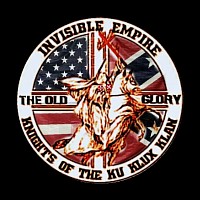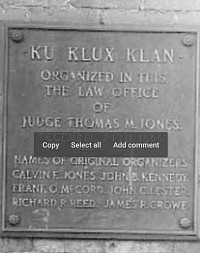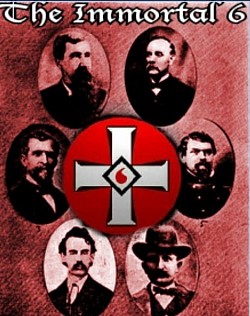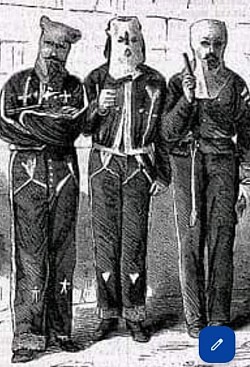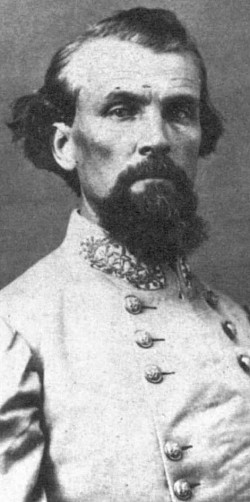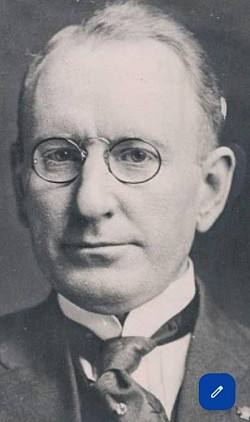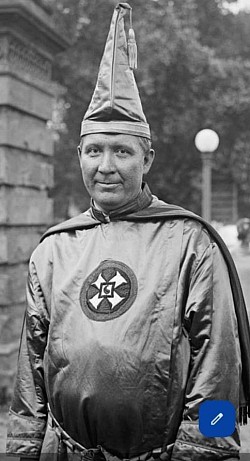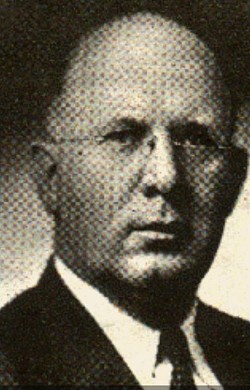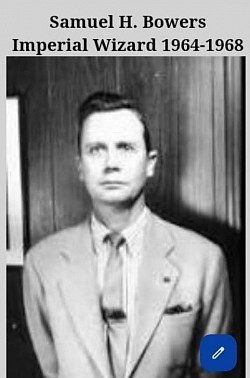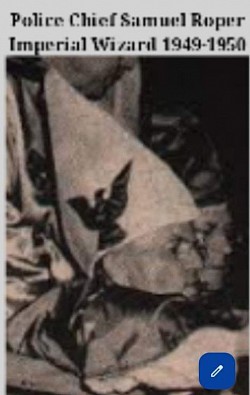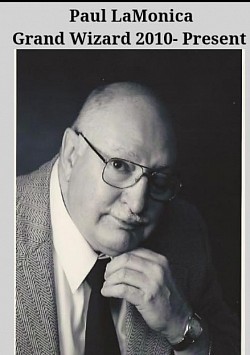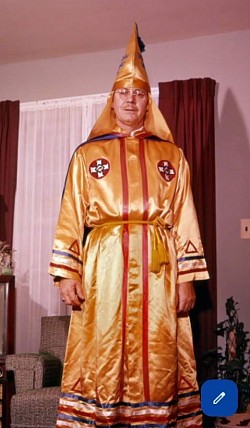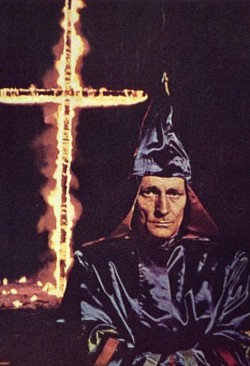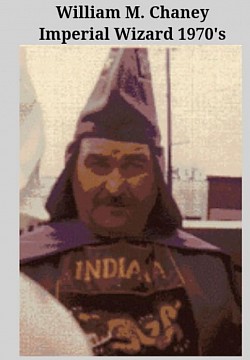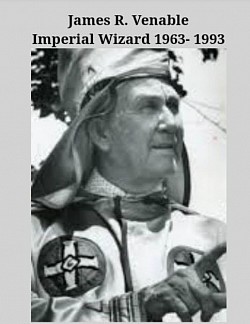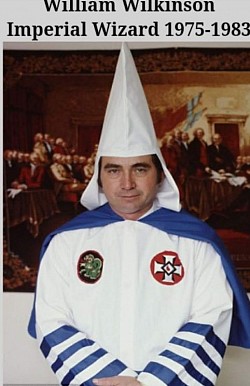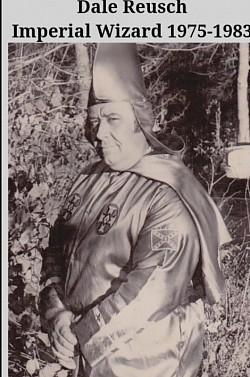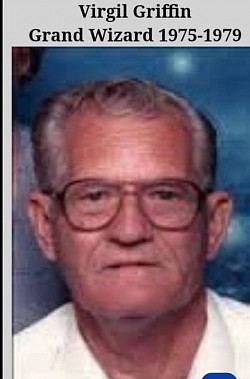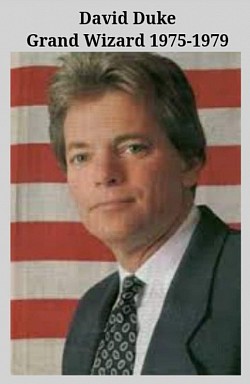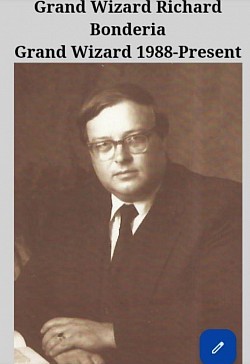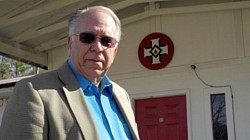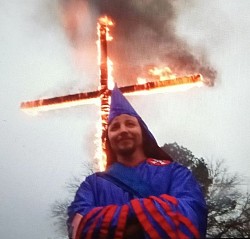History of the KKK
History of the Klan
The KKK was founded on December 24th 1865 by 6 men known as the immortal 6 or the jolly 6 in the law offices of judge Thomas M Jones the 6 men who founded the klan were John B Kennedy,Calvin E Jones,Frank O McCord,John C Lester,Richard R Reed and James R Crowe a little history on these men is Capt. Lester suggested forming the club. Capt. Kennedy mentioned ku klos (klos) meaning circle in greek as part of the new club's name. Maj. Crowe suggested changing it to "ku klux". Lester, then suggested adding "clan" to the name. John Kennedy repeated it and became the first man to speak the words ku klux Klan.
Capt. John C. Lester, born, 1834, Giles County, TN. Died Dec. 4, 1901, Hartsville, TN. Buried in Maplewood Cemetery, Pulaski, TN. Served in the 3rd Tenn. Infantry. He practiced law for a while, never married, and was a Christian (denomination not presently known).
Maj. James R. Crowe, born, Jan. 29, 1838, Pulaski, TN. Died July 14, 1911. Buried in Maplewood Cemetery. Served in the Marion Rifles, Co. G, 4th Alabama Infantry, later served with the 35th Tenn. Infantry. He attended Marion Military Institute and was a prominent factor in business and political life in Tennessee. A Free Mason, he attained the rank of Most Illustrious Grand Master of the Grand Council of TN. in 1866. He was a Cumberland Presbyterian.
Adj. Calvin E. Jones, son of Judge Thomas M. Jones, Born 1839. Died xxxx, Pulaski, TN. Served as adjutant of the 32nd Tenn. Infantry. He was a lawyer and a member of the Episcopal Church.
Capt. John B. Kennedy, born Nov. 6, 1841, Wales, Giles County, TN. Died Feb. 13, 1913, Lawrenceberg, TN. Buried in Monroe Cemetery, Lawrenceberg. Served in the 3rd Tenn infantry. His widow was present in Pulaski, TN. on May 21, 1917, when, amid much fan fare, the plaque, commemorating the law office where the KKK was founded, was placed on the outside wall of the building. Officiating at the ceremony was Mrs. Grace Neufield, former Tennessee state historian of the United Daughters of the Confederacy. Kennedy attended Center College, Danville KY.
Frank O. McCord, born Jan. 14, 1839, Giles County, TN. Died Aug. 19, 1895, Fayetteville, TN. Buried Rosehill Cemetery, Fayetteville. Served as a private in the Confederate Army and later became editor of the Pulaski Citizen. He was a member of the Methodist Church South.
Richard Reed, was a lawyer in Pulaski, TN. and served in the 3rd Tenn. Infantry. He was a Presbyterian.also as the founders established the organization the need a leader and the the title was to be Grand Wizard and the 1st was Confederate General Nathan Bedford Forrest Nathan Bedford Forrest (July 13, 1821 – October 29, 1877) was a prominent Confederate Army general during the American Civil War and the first Grand Wizard of the Ku Klux Klan from 1867 to 1869. Before the war, Forrest amassed substantial wealth as a cotton plantation owner, horse and cattle trader, real estate broker, and slave trader. In June 1861, he enlisted in the Confederate Army and became one of the few soldiers during the war to enlist as a private and be promoted to general without any prior military training. An expert cavalry leader, Forrest was given command of a corps and established new doctrines for mobile forces, earning the nickname "The Wizard of the Saddle". He used his cavalry troops as mounted infantry and often deployed artillery as the lead in battle, thus helping to "revolutionize cavalry tactics",[3] although the Confederate high command is seen by some commentators to have underappreciated his talents.[4] Although scholars generally acknowledge Forrest's skills and acumen as a cavalry leader and military strategist, he has remained a controversial figure in Southern racial history for his main role in the massacre of several hundred Union soldiers at Fort Pillow, a majority of them black, coupled with his role following the war as a leader of the Klan
Nickname(s)
Old Bed
Wizard of the Saddle
Born
July 13, 1821
Chapel Hill, Tennessee, U.S.
Died
October 29, 1877 (aged 56)
Memphis, Tennessee, U.S.
Buried
Health Sciences Park
Memphis, Tennessee, U.S.
Allegiance
Confederate States
Service/branch
Confederate Army
Years of service
1861–1865
Rank
Confederate States of America General-collar.svg Lieutenant General
Unit
White's Company,
TN Mounted Rifles
Commands held
3rd Tennessee Cavalry
Forrest's Cavalry Brigade
Forrest's Cavalry Division
Forrest's Cavalry Corps
Battles/wars
American Civil War
Fort Donelson
Shiloh
First Murfreesboro
Chickamauga
Fort Pillow
Brice's Cross Roads
Tupelo
Second Memphis
Third Murfreesboro
Nashville
Wilson's Raid
Then after disbanding in 1869 the klan was revised in it's start of the 2nd era by The Reverend Colonel William Joseph Simmons of Atlanta, Georgia.
While convalescing in 1915 after being hit by a car, Simmons decided to rebuild the Klan which he had seen depicted in the newly released film The Birth of a Nation directed by D. W. Griffith. He obtained a copy of the Reconstruction Klan's "Prescript", and used it to write his own prospectus for a reincarnation of the organization. Simmons' planning took place during a period which coincided with the lynching of Leo Frank, on August 16, 1915. Frank, a Jewish northern industrialist, had been convicted of murdering Mary Phagan, one of his young factory workers. When Frank's death sentence was commuted to life imprisonment by the outgoing governor, the public was outraged. Frank was taken from prison and lynched by a mob, calling themselves the Knights of Mary Phagan.
As the nucleus of his revived Klan, Simmons organized a group of friends, in addition to two elderly men who had been members of the original Klan. On Thanksgiving night 1915, they climbed Stone Mountain to burn a cross and inaugurate the new Klan, with fifteen charter members. Simmons' later account of the founding included a dramatic story of "a temperature far below freezing", although weather records showed that the temperature had never fallen below 45 °F (7 °C) that night on Stone Mountain.[citation needed] Simmons declared himself the Imperial Wizard of the Invisible Empire of the Knights of the Ku Klux Klan.
The imagery of the burning cross, which had not been used by the original Klan, had been introduced by Griffith in The Birth of a Nation. The film, in turn, had derived the image from the works of Thomas Dixon, Jr., upon which the film was based. He had been inspired by the historical practices of Scottish clans, who had burned crosses as a method of signaling from one hilltop to the next. The image also occurs in Lady of the Lake, a long poem by Walter Scott. The signature white robes of this new Klan also likely come from "The Birth of a Nation.In the first years of the new Klan, a few thousand members enrolled but eventually it became more popular and hundreds of thousands of new members pledged allegiance, particularly in industrial cities of the Midwest. Initially portraying itself as another fraternal organization, the Klan was opposed to the new immigrants from southern and eastern Europe, who were mostly Jews and Roman Catholics essentially and anybody else who was not a native-born Anglo-Saxon or Celtic Protestant.Later life and death Edit When the New York World exposed violent affairs conducted by the Ku Klux Klan, Simmons was called to testify in front of the U.S. House Committee on Rules. Hearings began in October 1921 and lasted for over a week. Simmons distanced himself from violent events and stressed the Klan's fraternal nature. Congressional hearings ended with no direct consequences for the Klan, though Simmons lost his influence.Having built up his own network of influence, Hiram Wesley Evans succeeded Simmons in the position of the Imperial Wizard in November 1922. Simmons was at the same time elected Emperor for life.The Klan started to decline after a peak of membership and influence.
The third era was brought upon us by Hiram Wesley Evans, Imperial Wizard
Evans in Washington, D.C., on August 8, 1925
3rd Grand Wizard of the
Knights of the Ku Klux Klan
In office
1922–1939
Preceded by
William Joseph Simmons
Succeeded by
James Arnold Colescott
Personal details
Born
September 26, 1881
Ashland, Alabama, United States
Died
September 14, 1966 (aged 84)
Atlanta, Georgia, United States
Political party
Democratic
Education
Vanderbilt University
Occupation
Dentist.Hiram Wesley Evans (September 26, 1881 – September 14, 1966) was the Imperial Wizard of the Ku Klux Klan, an American white supremacist group, from 1922 to 1939. A native of Alabama, Evans attended Vanderbilt University and became a dentist. He operated a small, moderately successful practice in Texas until 1920, when he joined the Klan's Dallas chapter. He quickly rose through the ranks and was part of a group that ousted William Joseph Simmons from the position of Imperial Wizard, the national leader, in November 1922. Evans succeeded him and sought to transform the group into a political power.Although Evans had led the kidnapping and torture of a black man while leader of the Dallas Klan, as Imperial Wizard he publicly discouraged vigilante actions, fearing that they would hinder his attempts to gain political influence. In 1923, Evans presided over the largest Klan gathering in history, attended by over 200,000, and endorsed several successful candidates in 1924 elections. He moved the Klan's headquarters from Atlanta to Washington, D.C., and organized a march of 30,000 members—the largest march in the organization's history he also created the degree test for the organization —on Pennsylvania Avenue. Evans' efforts notwithstanding, the Klan was buffeted by damaging publicity in the early 1920s, partially because of leadership struggles between Evans and his rivals, which hindered his political efforts. In the 1930s, the Great Depression significantly decreased the Klan's income, prompting Evans to work for a construction company to supplement his pay. He resigned his position with the Klan in 1939, after disavowing anti-Catholicism. He was succeeded by his chief of staff, James A. Colescott. The next year, Evans faced accusations of involvement in a government corruption scandal in Georgia; he was fined $15,000 after legal proceedings.Evans sought to promote a form of nativist, Protestant nationalism. In addition to his white supremacist ideology, he fiercely condemned Catholicism, unionism, and communism, which were associated with recent immigrants from eastern and southern Europe. He argued that Jews formed a non-American culture and resisted assimilation, although he denied being an anti-Semite. Historians credit Evans with refocusing the Klan on political activities and recruiting outside the Southern United States; the Klan grew most in the Midwest and industrial cities. However, they note that the political influence and membership gains he sought were transitory. Some commentators argue that Evans was more focused on money and power than any particular ideology.Early life and education
Initial Klan service
Early national leadership
Internal conflicts under Evans' tenure
Klan growth and political activism.Arnold Colescott
James A Colescott Portrait.gif
4th Grand Wizard of the
Knights of the Ku Klux Klan
In office
1939–1944
Preceded by
Hiram Wesley Evans
Succeeded by
Samuel Green
Personal details
Born
January 11, 1897
Terre Haute, Indiana, United States
Died
January 11, 1950 (aged 53)
Coral Gables, Florida, United States
Nationality
American
Spouse(s)
Louise
Occupation
Veterinarian James Arnold Colescott (January 11, 1897 – January 11, 1950) was an American who was Imperial Wizard of the Knights of the Ku Klux Klan. Under financial pressure from the Internal Revenue Service (IRS) for back taxes, he disbanded the second wave of the original Ku Klux Klan in 1944.
Samuel Green
5th Grand Wizard of the
Knights of the Ku Klux Klan
In office
August 4, 1949 – August 18, 1949
Green was born on 13 November 1889 in Atlanta, Georgia.He became an obstetrician and joined the Ku Klux Klan in 1922.[2] By the early 1930s, Green had become the Grand Dragon of Georgia.Starting from the late 1920s, the Knights of the Ku Klux Klan had a problem with declining membership. In 1939, Imperial Wizard Hiram Wesley Evans sold the organisation to two Klan members, Green and James A. Colescott.Colescott served as the Imperial Wizard and Green as his assistant. While Colescott was forced to dissolve the organization in 1944, Green began to reform the Association of Georgia Klans with its focus on white supremacy and anti-communism.[5] In October 1945, his group announced their return to public life with a cross-burning.From the autumn of 1945 to the spring of 1946, the Klan regularly signaled their presence through lighting up "huge fiery crosses" on top of Stone Mountain. During this period, Green and his associates started contacting former Klansmen and inviting them to rejoin the ranks. On May 9, 1946, this version of the Klan staged its first major initiation ceremony.In October of the same year, Green orchestrated a formal revival ceremony on Stone Mountain. According to historian Robert P. Ingalls, the fiery cross lit for the ceremony was between 200 and 300 feet in height (60,96-91.44 metres). The initiation ceremony of the night closely followed the patters established by William Joseph Simmons in 1915. The only problem for the ceremony was that there were more members and initiates present than robes and hoods available to them. Many of them wore handkerchief masks instead of more traditional Klan uniforms. Green sold to Life magazine the rights of taking and publishing photos of the event.New Klan units soon emerged throughout the Southern United States. Chester L. Quarles, a professor of criminal justice at the University of Mississippi, points out that new conditions in the region helped the Klan in its recruitment drive. One factor was the supposed "new assertiveness" of the Negroes. In other words, African American veterans of World War II were returning home. Having fought for liberty and freedom abroad, they were now demanding these rights for themselves in their own homeland. They were joining the Civil Rights Movement en masse. In response, the Klan re-embraced its original goals of seeking to contain and control the Negroes.[6] In Green's own words on the subject:...The uppity niggahs! Since the war they're even trying to abolish Jim Crow laws, with their talk of equal rights. Already the poll tax has been abolished in Georgia, and in other Southern states Northern agitators are paying poll taxes for the blacks so they may vote alongside white folks. ...
The Klan focused its recruitment drives towards White American veterans of the war who felt restless. Their rhetoric called attention to non-combatant negroes "who got all the good jobs while you were in uniform".Another factor to the revitalization of the Klan was a then-recent wave of refugees and immigrants entering the United States, including Jews who survived the Holocaust. Green described the country as having been "flooded with Jewish refugees". The Klan once again embraced both nativism and antisemitism.A third factor was that Roman Catholicism was increasing its influence over the American population, gaining new adherents. Green found this to be a disturbing trend and spoke against these "papists". Meaning that the Klan was re-embracing Anti-Catholicism. The final factor was the ongoing Operation Dixie, which involved labor organizers operating in the South. The Klan was opposed to the labor movement and Green characterized these organizers as carpetbagger arriving to "tell Southerners how to run ... their business". Green assured his audience that "niggahs" (sic), Jews, Catholics, labor organizers, and any alliance between them would not be tolerated by the Klan. In his words:The white man was born supreme. ...We didn't want to be reconstructed, and we don't want to be organized!In this period of the Klan, it was relatively normal for Klansmen to attend church service in full uniform. The practice both asserted their predominance in their respective areas, and implied their connection to local church leaders. At times these Klansmen offered cash donations to the congregations. At least some religious figures opposed the practice. For example, Hugh A. Brimm of the Southern Baptist Convention instructed its pastors to refuse to accept "blood money" from the Klan. In his view the Klansmen were covered with the blood of "lynched victims" and their "superficial piety" was merely hypocritical.[6] In 1947, the Klan was included in the Attorney General's List of Subversive Organizations, and denounced as Un-American. It shared the list with organizations embracing totalitarianism, fascism, and communism. In the Klan's case, the list accurately reflected their subversive ideology. While declaring itself the "American social conscience", the Klan consistently favored ignoring and disobeying laws which went against their ideology. Their rhetoric had taken an increasingly anti-statist turn.With the Klan attracting some negative attention, it soon started facing internal problems. Their ranks were infiltrated by government informants, federal agents, and investigative journalists. All were eager to expose the violent nature of the Klan, the one Klansmen publicly denied. The most notable infiltrator was Stetson Kennedy, whose later book I Rode With The Ku Klux Klan (1954) covered the activities of the Klavalier Klub. The Klub was an elite squad of Klansmen devoted to flogging campaigns, active within Georgia itself.By 1949, following the revelations to the public, the Klan's name had become synonymous with terrorism and violence. But this reputation failed to discourage people from seeking membership. In the summer of 1949, shortly before his death, Green himself presided in a major initiation ceremony. About 700 members joined in a single day.Meanwhile, Green led the Klan in renewing its political activities. He was active in the Georgia gubernatorial special election, 1948, reportedly serving as an aide-de-camp to candidate Herman Talmadge. Talmadge was seen as the Klan's candidate for the office. When he did win the election, the Klan took credit for it. According to Stetson Kennedy, Talmadge had promised the Klan "a free hand in any racial rioting".He was elected Imperial Wizard two weeks before his death from a heart attack in Atlanta, Georgia on 18 August 1949. He died in the rose garden of his home. His death weakened the Klan by further splintering its leadership.
Samuel Roper
6th Grand Wizard of the
Knights of the Ku Klux Klan
In office
August 18, 1949 – 1950
Prior to his position in the KKK, Roper was an Atlanta, Georgia police officer and the second Director of the Georgia Bureau of Investigation. After leaving law enforcement, in 1949, Roper succeeded Samuel Green as Imperial Wizard of the KKK, and held that position until 1950.His successor was Eldon Edwards.Roper moved to Florida in 1972 and was a resident of Chiefland, Florida at the time of his death.He died of kidney failure at the Veterans Administration Hospital in Gainesville, Florida on March 1, 1986. Eldon Lee Edwards (June 8, 1909 – August 1, 1960[1]) was an American Ku Klux Klan leader.
Eldon Edwards
7th Grand Wizard of the
Knights of the Ku Klux Klan
In office
1950–1960Edwards was an automobile paint sprayer from Atlanta, Georgia, and rebuilt the Klan beginning in 1953. In his book "The Informant: The FBI, the Ku Klux Klan, and the Murder of Viola Liuzzo", Gary May notes that Edwards became prominent at a time when the Klan was splintered into different local groups. In 1955, Edwards created his own organization - "U.S. Klans, Knights of the Ku Klux Klan" - and established a 15,000 strong following in nine U.S. states.
Edwards was interviewed by Mike Wallace on May 5, 1957, as noted in Wallace's 2006 book Between You and Me.
Edwards, long diagnosed with heart disease, died of a heart attack in Atlanta on August 1, 1960. In his last public appearance, Edwards said, "We have more right to organize than the communists and the NAACP," and added, "We white people are the inheritors of this country. We do not intend to surrender it…
Robert Marvin Shelton (June 12, 1929 – March 17, 2003) was a former car-tire salesman and printer who became nationally famous as the Imperial Wizard of United Klans of America 1st Grand Wizard of the
United Klans of America Inc.
In office
1960–1987
Preceded by
Position Established
Succeeded by
Position Abolished
Personal details
Born
Robert Marvin Shelton
June 12, 1929
Died
March 17, 2003 (aged 73)
Residence
Tuscaloosa, Alabama, U.S.
Occupation
factory worker, car-tire salesman, printer
Known for
Imperial Wizard of United Klans of America
Early life
Career Edit
Shelton was a factory worker and a car-tire salesman.He also owned a printing business, with an office on Union Boulevard.In the late 1960s, Shelton ran for Police Commissioner in Tuscaloosa, Alabama. He finished in fifth place.Shelton served as the UKA leader starting in 1961, which peaked with an estimated 30,000 members. In 1966 Shelton received a year in prison and $1,000 fine for contempt of the United States Congress, "for refusing to turn over membership lists to the House Committee on Un-American Activities."In 1984, James Knowles, a UKA member of the UKA's Klavern 900 in Mobile, was convicted of the 1981 murder of Michael Donald.At trial Knowles said he and Henry Hays killed Donald "in order to show Klan strength in Alabama." In 1987, the Southern Poverty Law Center (SPLC) brought a civil case, on behalf of the victim's family, against the United Klans of America for being responsible in the lynching of Donald, a 19-year-old black man.Unable to come up with the $7 million awarded by a jury, the UKA was forced to turn over its national headquarters to Donald's mother, who then sold it.During the civil trial Knowles said he was "carrying out the orders" of Bennie Jack Hays, Henry Hays' father and a long-time Shelton lieutenant.In 1994, Shelton said, "The Klan is my belief, my religion. But it won't work anymore. The Klan is gone. Forever..
James R. Venable, an attorney,and grand wizard.
His family at one point owned Stone Mountain, the scene of the Klan's two revivals.
The Klan group he eventually founded was called the National Knights of the Ku Klux Klan, which he ran until his death in 1993.. James R. Venable, an attorney, was a personal friend of Col. Simmons and Dr. Green. His family owned Stone Mountain, the scene of the Klan’s two revivals. The Klan group he eventually founded was called the National Knights of the Ku Klux Klan, which he ran until his death in the 1990’s (exact date pending). To his credit, he ran his Klan much like the Simmons Klan with its regalia, emblems, degrees, and Klankraft virtually intact. Being an attorney, he also kept his Klan relatively out of trouble. Unfortunately for him, his Klan also went into decline as a result of the bad image the violent Klan’s had given to all Klan organizations. After the general decline of the late 1960’s, Venable’s Klan settled down into a private fraternal social club Klan. When he died his family folded the National Knights. Since then the name of the National Knights has been picked up and is being used by others. Samuel Bowers
1st Grand Wizard of the
White Knights of the Ku Klux Klan
In office
February 15, 1964 – 1989
Bowers, along with many other southern whites, was antagonistic towards the civil rights movement, believing it to be a movement led by the far left and organized by the Communist Party.Bowers perceived the original Ku Klux Klan as being too passive. On February 15, 1964, at a meeting in Brookhaven, Mississippi, he convinced about 200 members of the original Knights to defect and join his Klan, to be called the White Knights of the Ku Klux Klan. He became the group's fraternal "Imperial Wizard." Bowers adopted a code of secrecy. Bill Wilkinson (KKK), Imperial Wizard of the Invisible Empire Knights of the Ku Klux Klan from the mid-1970s to 1981. Samuel H. Bowers, a saw mill owner, ran a major Klan group, the White Knights of Mississippi, but its power and membership were mostly limited to the state of Mississippi. Bowers commanded tremendous power in his home state and literally launched a murderous reign of terror against the Civil Rights movement there. He took on the full power of the federal government doing irreversible damage to the reputation of all Klan’s as a result. Apparently, he must have thought he was living in the 1860’s and not the 1960’s. You can’t go around murdering people, burning churches, and bombing buildings and expect no one to do anything about it. By the late 60’s, while he was in prison, along with many of his followers his Klan went defunct. The name, White Knights, is used by several Klan groups today.
William Chaney William M. Chaney, a one time deputy sheriff and constable, split from the UKA and founded the Confederation of Independent Orders, Invisible Empire Knights of the Ku Klux Klan which began growing to reasonable size. I knew his Pennsylvania Grand Dragon, Ray Doerfler, who confided in me that at their height Chaney had 1,300 members between Pennsylvania and New Jersey alone. He ran his Klan as a republic with each state having considerable autonomy. Unfortunately for him, his Klan went defunct when he lost a court appeal in 1977, concerning a bombing incident. Let’s face it, lawmen shouldn’t break the law. In the 1970’s, total Klan membership (all groups combined) was around 15,000.
Dale Reusch
William WilkinsonWilliam Wilkinson, ex-submariner, founded his Invisible Empire, Knights of the KKK in 1975. He was often described as a media slick southerner. He was later repudiated as an FBI informer. During the 1970’s and early 1980’s, his Klan was among the four largest. He at least tried to create a polished professional image for his Klan. When Wilkinson stepped down in 1983, his Klan went defunct from fragmentation and incredibly corrupt bad leadership.
David Duke
5th Grand Wizard of the
Knights of the Ku Klux Klan
In office
1974–1979/1980. Member of the Louisiana House of Representatives
from the 81st district
In office
February 18, 1989 – January 13, 1992
Preceded by
Chuck Cusimano
Succeeded by
David Vitter
Personal details
Born
David Ernest Duke
July 1, 1950 (age 68)
Tulsa, Oklahoma, U.S.
Political party
American Nazi (before 1975)
Democratic (1975–1988)
Populist (1988–1989)
Republican (1989–1999; 2016–present)[2]
Reform (1999–2001)
Children
2
Education
Louisiana State University, Baton Rouge (BA)
Website
davidduke.com
A former Republican Louisiana State Representative, Duke was a candidate in the Democratic presidential primaries in 1988 and the Republican presidential primaries in 1992. Duke also ran unsuccessfully for the Louisiana State Senate, United States Senate, United States House of Representatives, and for Governor of Louisiana.
In 2002, Duke pled guilty to felony fraud. Specifically, he defrauded his political supporters by pretending to be in dire financial straits, and asking them for money to help him pay for basic necessities. At the time, Duke was financially secure, and he used his supporters' money for recreational gambling.He subsequently served a 15-month sentence at Federal Correctional Institution, Big Spring in Texas.Duke speaks against what he alleges as Jewish control of the Federal Reserve Bank, the U.S. federal government, and the media. Duke supports the preservation of what he considers to be Western culture and traditionalist Christian family values, as well as abolition of the Internal Revenue Service, voluntary racial segregation, anti-communism, and white separatism.
Virgil Lee Griffin ( 1944 – February 11, 2009) was a leader of the Ku Klux Klan who was involved in a 1979 violent clash with Communist party organizers in North Carolina.Griffin was born to Johnny and Lizzie Griffin. He had a brother John and three sisters Geraldine, Francis and Janie. He grew up picking cotton and played with blacks as a child and then he worked at a gas station as a "halfway mechanic".He joined the Klan when he was 18. His reason for joining the organization was because he did not believe in mixing the races, particularly in marriage. Griffin claimed that the African-American customers he served at the gas station would ask for his services personally despite their awareness of his KKK membership: "As much as I'm on TV, I'm sure everyone of them knew I was in the Klan. They knew what I was. And I knew they was in the N.A.A.C.P. What they do is their business."Greensboro massacre The Klan brought Griffin notoriety, but it was the November 1979 Greensboro rally held by members of the Communist Workers Party where Griffin won his biggest headlines. Griffin became known nationally when five Communist marchers were killed in a clash with members of the Klan in Greensboro. On the morning of the shootings, Griffin's Klansmen and American Nazis, in a nine-vehicle caravan, veered from the destination and drove through the rally. Griffin told his members to go without robes and guns."We had just planned to fly our American flags across the street to show them we love our country," Griffin said.The Klansmen and the Nazis drove a caravan of cars through the throng of leftist demonstrators. Everybody seemed to agree that the leftists began hitting the cars, but accounts of what happened next differed widely. The leftists contended that the Klansmen and the Nazis left their cars and opened fire with shotguns, rifles and pistols. Five leftists were killed and 10 injured. The Klansmen and Nazis contended that they reacted in self-defense to having their cars attacked. They said the leftists fired the first shot. Griffin said the shots that hit the demonstrators were not aimed at them."Someone fired a shot -- and all hell broke loose," Griffin said. "We had every right to be drive down that street with nobody touching the cars. I didn't come to shoot or kill nobody."Griffin maintained that the shootings were not planned. Klansmen said the fight broke out between the groups because Communists tried to pull a 79-year-old Klansman out of his car.In 1980, six Klansmen and Nazis, not including Griffin, were acquitted of murder charges in North Carolina state court. In 1984, after a three-month trial, Griffin was among nine acquitted in federal court on charges of violating the leftists' civil rights. Griffin was tried and cleared of state murder charges and federal civil rights conspiracy charges.
In 2005, he told a group studying the Greensboro massacre that he never would have gone to that rally had he not been goaded.At a forum in 2005, Griffin was asked why no Klansmen were killed in the crossfire: "Maybe God guided the bullets."In 1965, Griffin and another man were convicted of posing as detectives investigating a racial incident at a school. In 1980, Griffin was charged in a cross burning in Lincoln County.In 1979, he was identified in The New York Times as Grand Dragon of the North Carolina Knights of the Ku Klux Klan. He later founded the Christian Knights of the Ku Klux Klan and has most recently been identified as the imperial wizard of the Mount Holly-based Cleveland Knights of the Ku Klux Klan.For most of the last three decades, the Klan has lost both prominence and viciousness, according to the Anti-Defamation League and other anti-hate groups. But its opposition to illegal immigration has helped draw new sympathizers, and Griffin tried to be a leader in that effort. "Shoot one, and let them know we are sealing our borders," Griffin said in an interview with WCNC.com of Charlotte, North Carolina. He and other Klan officials were in the midst of rebuilding, exploiting fears over illegal immigrants. "People are tired of this mess," Griffin told The Charlotte Observer in 2007. "The illegal immigrants are taking this country over."
Richard Bonderia Grand Wizard, Richard Bonderia, is a former Republican Party County Committeeman and published writer,noted historian, Great Blufustin of the Ku Klos Knights, (among other things). He reigns over Greater Klandomas the Grand High Exalted Mystic Wizard, K-Quad, Knight of the Midnight Mystery who traversed the Realm of the Unknown, wrested the Solemn Secret from the grasp of Night and became the Imperial Master of the Great Lost Mystery and from his Aulik brings words of timely Wisdom and out of Mystic Darkness brings Light.
Paul LaMonica Grand Imperial Wizard, Paul Lamonica, joined the Klan in 1978. Throughout the years have held many offices, from the Exalted Cyclops, Imperial Koltropp to the Grand Wizard. And in the true klan tradition, a proud Republican.But, most Klans of the 1990’s did not survive. Fly by night Klan groups were popping up and falling apart in the 1990’s on such a regular basis that you could almost set your watch to them. There was an endless parade of member less leaders comprising everything from con artists out to shake down suckers for dues and donations, to psychos and criminals, to ego maniacs out to build their own personal power structures. Their main past time was tribal warfare and infighting. They were too numerous and too insignificant to bother to mention by name. Already in the 21th century numerous new Klan groups have formed up and a number of them have already fallen apart. Ad infinitum, adnauseaum.
Thomas Robb (born 1946) is an American white supremacist, Ku Klux Klan leader and Christian Identity pastor. He is the National Director of The Knights Party, also known as the Knights of the Ku Klux Klan, taking control of the organization in 1989.
Thomas RobbBorn1946
Detroit, Michigan, United StatesTitleNational director of the Knights of the Ku Klux Klan
Pastor of the Christian Revival CenterEarly life
Robb was born in Detroit, Michigan, and grew up in Tucson, Arizona. He attended college in Colorado.
Christian Identity and Klan activities
Robb is the pastor of the Christian Revival Center in Zinc, Arkansas, a Christian Identity center where Robb espouses racism and antisemitism. Robb's "Thomas Robb Ministries" website declares that "the Anglo Saxon, Germanic, Scandinavian, and kindred people are THE people of the Bible."
In 1989, Robb took over the Knights of the Ku Klux Klan, originally led by David Duke. In a bid to gain mainstream acceptance, he took the title of "National Director" instead of "Imperial Wizard", and chose to rename the organization "The Knights Party".He also decided to accept members via mail-in forms, rather than through initiation rites that had been common Klan practice in the past. Robb defends the Klan as a harmless organization, claiming that it is "gentle, upbeat, and friendly";when featured in the PBS documentary Banished, Robb compared a Klan hood to a businessman's tie, claiming that "it's just tradition".
Robb has maintained ties to other far-right groups; he has spoken at the Aryan Nations' annual "World Congress" of hate group leaders, appeared on Jamie Kelso's white supremacist Voice of Reason Radio Network, and contributed regularly to the white supremacist Internet forum Stormfront.In 1996 Robb began to pioneer the concept that white people were being targeted for genocide.
In 2009, Robb's daughter Rachel Pendergraft and his granddaughters, Charity and Shelby Pendergraft, formed a "white nationalist" band called Heritage Connection.
Robb's Party publishes The Crusader, a quarterly publication. In November 2016, just days before the presidential election, Robb wrote a front-page article under the title "Make America Great Again" in The Crusader, devoted to a lengthy endorsement of Donald Trump and Trump's message. The Trump campaign responded by denouncing The Crusader article.
Daniel Lane Walls Daniel Walls was born on January 14th 1985 in Columbia Tennessee a native from Santa Fe Tennessee in Maury county joined the Klan in 2009 under the bayou knights in Louisiana was with the organization for 2 years then resigned after obtaining K UNO degree then in 2015 joined another klan organization the patriotic brigade knights and was also with them for 2 years 2015-2017 upon resignation there went on to Southern white knights where he would be Grand Dragon after obtaining K DUO degree and only had a short stint with them of 6 months in 2017 due to the organization not abiding by the constitution and laws of the invisible empire from there would go on to join the American Christian Dixie Knights in 2017-2019 and would earn his K TRIO degree and become an imperial Klokard teacher of Kraft and writer and creator of all the files in the PDF you are reading now but after a divide in the organization he would resign and join United Klan Nation as the Imperial KLAZIK which later would become Imperial Klaliff he remained there from 2019-2020 and as the group went turmoil and split he would join the Knights Party under Pastor Thomas Robb in 2020 and earned all their degrees such as klansman page squire and knight and remained with the organization up until he would get chartered and become the Imperial Wizard of The Old Glory Knights of the Ku Klux Klan on March 14th 2021 where he is currently and leads the Christian based organization by his faith in God and his knowledge of the Invisible Empire and vows to do so as long as their is blood in his veins and in sound mind body and spirit and was invited to join the Knights of Midnight Mystery by Ku Klos Knights IW and K Quad Barney Ross and Walls became a K Quad in 2023 the highest honor a klansman can achieve.
